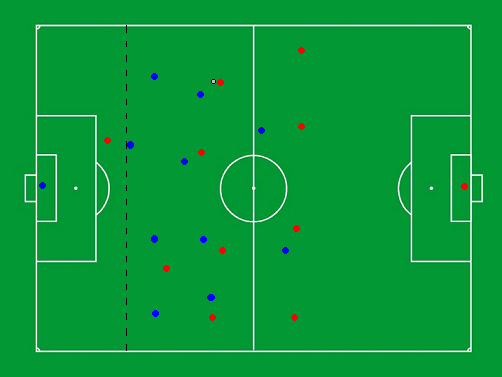When and why does p appearthe rule for an ambush in football ?
What changes have there been over the years?
The cliché says that if a woman knows what an ambush is, then she knows football and you can safely watch a match with her without receiving inappropriate questions. This rule in the world's favorite game is one of the main ones that turned football into what we know today. But do you know why the ambush has to be introduced? When does this happen? And has there been anything that has changed over the years? In the following lines, we will try to answer these questions.
But first, let's explain what an ambush is, because there may be someone who is not aware. A player is in an irregular position when any part of his body with which the ball can be played (excluding the hands) is in the opponent's half and is closer to the opponent's goal line than the ball and more than one player of the opposing team at the moment. in which he receives a pass from a teammate. Or more simply put - if at the moment of the pass between the player who receives the ball and the goal line there is one or less players and he is in front of the ball line, then he is in an ambush.
Originally, there was no such rule in football and in the early years of the 19th century there was always a player from the opponent near the goal, which created a lot of difficulties and football was not as interesting as it is today. It is in an attempt to stop the inevitable stay of at least one football player in the immediate vicinity of the opponent's goal that the ambush is introduced.
On November 17, 1863, the newly established Football Association in England found a solution to the problem and introduced a new rule in the game, borrowed from elsewhere. It states that a footballer is in an irregular position the moment he is in front of the ball and must get back behind it as quickly as possible. If the ball is kicked by one of his teammates and he is in front of it, he is not allowed to play it until someone from the other team has done so. Something similar to the rules in rugby where we don't have a forward pass. A few days later, the rule was slightly changed, since when a kick is taken from the goal, there can be no player of the team taking the kick who has the right to play the ball. This is introduced as an exception so that everyone can fight for the first ball.
However, this rule seems too strict and quite restrictive, and most often as many as 10 people from the attacking team were in an irregular position. On this occasion, in February 1866, the first major change followed. With it, a player remains in an irregular position if, at the time of the pass, he is in front of the ball and there are not at least three opponent players between him and the goal line. This does not apply when taking a goal kick. A rule that is extremely close to the current one and brings back the slight advantage of attacking football.
Conflicts and desires of various people and teams for changes in the rule immediately begin. As early as 1867, representatives of the Barnes Football Club proposed that the rule be abolished because the attacking players were distracted by constantly counting how many players were between them and the opponent's goal line. In 1868, 71 and 72 they wanted a return to the stricter rule. There are also attempts to introduce a rule of only one player between the receiver of the ball and the goal line. The ambush caused serious friction between the Football Association and the Sheffield Football Clubs Association. Eventually, the teams from this part of England accepted the FA rule in 1877.
In 1907 came the new, more serious change. It cancels the offside if the player receiving the pass is in his own half, i.e. you cannot be ambushed in your part of the field. Practically as it is to this day. The proposal was initially rejected 2 years earlier, but the FA eventually introduced it in March 1907. A few months later, it was confirmed by the International Football Association.
After unsuccessful attempts by the Scottish Football Association to reduce the number of players between the attacking player and the goal line to two, as is the case today, in 1925 this rule was finally introduced. Several different International Football Association meetings were canceled because of the First World War, but even before that the IFAB rejected the Scots' proposal. Eventually, on March 30, 1925, 5 years before the first World Cup, the offside rule was changed to a version that is almost the same as it is today. The difference is that there must be two players between him and the goal line, and if he is on the same line as the first of them, he is again in an ambush.
Only in the 1990s was the rule that we know today and that we wrote to you at the beginning of the article. The player can now be in line with the player closest to him at the time of the serve. This is done to give attacking football a bit more of an edge, although it makes it extremely difficult for sideline referees.
And to make it even more complicated for them, the IFAB tweaked the offside rule by introducing the phrase "part of the body with which a goal can be scored". If a part of the attacking player such as head, leg, knee etc. is behind the competitor closest to him, then an ambush is awarded. In 2016, it became clear that the "body parts" rule applies to both the attacking player and the defender. In addition, the rule for ambushes in the own half is also slightly changed. If part of the attacking player's body has crossed this line, then he is in an ambush.
The rule is definitely not easy at all, it has undergone seemingly small but very significant changes to observe the game as it is today. With the introduction of the video arbitration system, more and more subtle ambushes are awarded, which are sometimes not visible to the naked eye. Arguments over whether or not a goal should have been awarded, however, will always remain.




